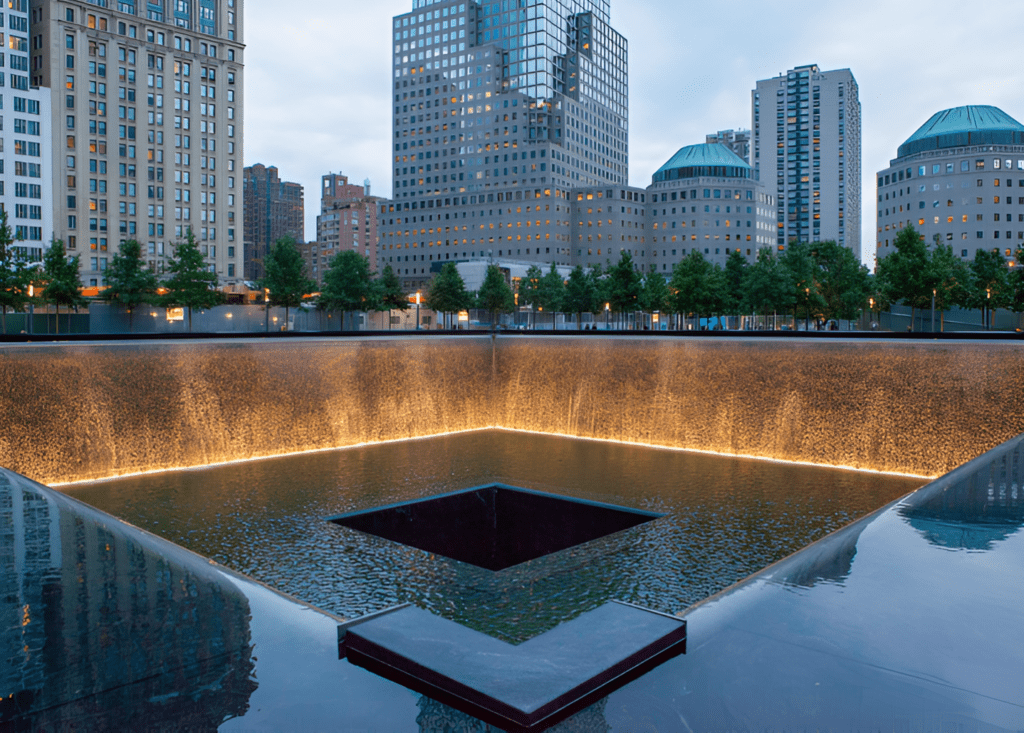The National 9/11 Memorial & Museum is a place of resilience and remembrance Set in the Ground Zero of New York City, but a powerful tribute to those who lost their lives in the terrorist attacks of September 11, 2001. A Day of Remembrance located in Lower Manhattan, this site honors the nearly 3,000 who died.
History of the Memorial and Museum
Soon after the 9/11 attacks, the idea to build a memorial also takes birth. The memorial, designed by architect Michael Arad and landscape architect Peter Walker, opened on September 11, 2011. It traces the boundary of where the Twin Towers stood, creating an area for remembrance and memorial.
The 9/11 Memorial Design
At the core of this memorial are two nearly one-acre reflecting pools. It might be these pools where the water flows over a knife edge and apparently into nothing. The names of almost 3,000 victims are inscribed in bronze panels stenciled around the pools so that visitors can reach out and touch them to remember each life lost. The design is in search of the representation of absence, loss, and continuity.
The Memorial Pools Features
The scale of the original towers is illustrated by a reflecting pool at each location, representing where the Twin Towers once were. Waterfalls drown out the noise — the most significant machine-made cascading ones in North America. Names of victims are placed together in a way that honors how they knew and were connected, so close friends or professional colleagues never would be separated by the panels.
The 9/11 Memorial Glade
The 9/11 Memorial Glade, which opened in 2019, honors those survivors and first responders suffering from toxic exposure. Six great monolithic stones line that path, a testament to the survivors all these years later.
The 9/11 Museum: A Pathway Through Time
Covering the underbelly of that memorial is a museum highlighting 9/11 and all it stood for; virtually nothing is swept beneath its rug there. Founded in 2014, the museum features artifacts and multimedia exhibits sponsored by numerous funders. Its storytelling personalizes the emotions of that day and its events as well as the aftermath; it engages all who cross these sacred borders with a narrative experience.
Exhibitions at The Museum
Key artifacts of note include the “Survivor Stairs,” a staircase that served as a critical escape route, and the last steel column removed from ground zero. While personal items, broken things, and first responder equipment paint a portrait of the day. News of the day displays, multimedia exhibits replaying newscasts, and recorded voicemails demonstrate just how emotional things were.
Personal Stories & Fostering Memorialization
Here’s where the victims are remembered in a section called ‘In Memoriam‘ – each of them is immortalized with their photo, bio, and personal information. This smaller room makes a point of focusing on the individual people who have died and those they left behind. At the same time, audio recordings of the victims’ families can at least make us hear some sounds related to grieving without any visualization; still, keep in mind that this is just paying a bit of tribute.
Educational Programs & Outreach
The 9/11 Memorial & Museum has broad educational programs for school kids and educators, in addition to global visitors. These initiatives aim to ensure the next generation remembers this tragic day through empathy-building policies, resilience programs, and historical education. These provide schools and global visitors with the means to take virtual tours, encountering displays that are capable of triggering emotional reactions as effectively as they would in person.
Honor to the first responders and recovery efforts
The museum’s exhibitions highlight stories of first responders who bravely risked or sacrificed their lives. Modern history exhibits honor the heroic work of firefighters, police officers, and medics. Rescue and Recovery showcases photos, videos, and stories from immediate efforts on that day, then transitions into the ongoing work across weeks and months.
Architectural and Symbolic Building
The resilience is a part of the symbolism that itself was woven into the design of both the memorial and museum. The water, flowing into a chamber through the night and out again with every dawn, carries meaning — loss, and renewal, while its downward traveling path brings forth reflection on the museum’s structure too, which slowly descends to earth – in memory of what was heavier upon our consciousness. Wide open spaces lend themselves to contemplation, reminiscent of hope and power.
Visitor Experience
Starting above ground, visitors confront two pool memorials, then descend into the still, quiet halls of a reflective museum. With audio guides, interactive displays on the island, and volunteer-led tours, an immersive experience is guaranteed. Guests depart with a profound sense of how the attacks affected real people, families, and the planet.
Memorial Plaza and Environmental Design
At the Memorial Plaza are more than 400 white oak trees, a designed symbol of peace and respite. The “Survivor Tree,” a Callery pear tree that survived 9/11, is at the heart of this monument. In contrast, the plaza offers a green oasis in the urban environment, serving as a space for contemplation and rejuvenation.

